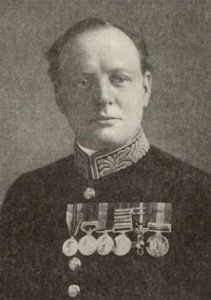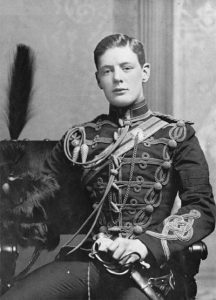
Young Soldier
London to Ladysmith via Pretoria

Winston Churchill, Parliament Square, London © Sue Lowry & Magellan PR
October 17, 2008
Richard M. Langworth
Finest Hour No. 105 Winter 1999-2000
Portions of this article are excerpted (omitting technical details and appraisals) from the author’s book, A Connoisseur’s Guide to the Books of Sir Winston Churchill.
I often wish modern writers who say Churchill was a racist would read his conversation with his Boer captors in London to Ladysmith. This was–remember–1899, when every Englishman alive supposedly believed in the utter supremacy of the white race, English branch.
“Is it right,” the guard asked Churchill, “that a dirty Kaffir [native] should walk on the pavement [sidewalk] without a pass? That’s what they do in your British Colonies. Brother! Equal! Ugh! Free! Not a bit. We know how to treat Kaffirs….They were put here by the God Almighty to work for us. We’ll stand no damned nonsense from them. We’ll keep them in their proper places.”

2025 International Churchill Conference
After recording his guard’s opinions Churchill states his own: “What is the true and original root of Dutch aversion to British rule? It is the abiding fear and hatred of the movement that seeks to place the native on a level with the white man. British government is associated in the Boer farmer’s mind with violent social revolution…the Kaffir is to be declared the brother of the European, to be constituted his legal equal, to be armed with political rights…nor is a tigress robbed of her cubs more furious than is the Boer at this prospect.” After the statements of his captor, Churchill concludes, “[he and I had] no more agreement…Probing at random I had touched a very sensitive nerve.”
Now it is accurately said that Churchill’s view of native Africans was not that of, say, Martin Luther King, Jr. half a century later. Churchill was paternalistic, and held, if not in these pages then in My African Journey, that immediate equality was impractical and unworkable. But his views in the Ladysmith are in striking contrast to those of most contemporary Britons. Of course, whatever improvements might have evolved in a South Africa under British suzerainty, the Union of South Africa in 1910 led to something different. By combining the Boer-dominated Transvaal and Orange Free State with the British Cape Colony and Natal in a Union where only whites could vote and Boers outnumbered Britons, Great Britain established the Boer patrimony which the Boers had failed to achieve by arms; and from that Union grew the policy of Apartheid. It is interesting to find Churchill in 1899 representing the same essential approach to native emancipation as the South African reformers of the early 1990s‹and agreeable to know that Nelson Mandela is an admirer of Winston Churchill.
Ever in search of adventure, Churchill in 1899 attached himself to the 21st Lancers and followed the flag to South Africa. There, a rebellion against British authority had broken out among the Boer settlers of the Transvaal and Orange Free State, and a Boer Republic had been proclaimed.
Churchill secured an assignment as press correspondent to The Morning Post, but he had scarcely arrived before he was involved in a skirmish which found him “in durance vile”: a prisoner of war in Pretoria, unable to talk himself out of prison by claiming to be a reporter, and nearly mad over the lack of action. Typically, he made a daring escape, traveling overland toward Lorenço Marques, Portuguese East Africa (now Maputo, Mozambique), hiding by day and moving by night. The true-life adventure story of his successful escapade dominates this book, one of the most gripping in the canon, making this one of his most popular works.
The escape story in the Ladysmith should be read in tandem with Churchill’s later remarks on the subject in My Early Life. The latter work, published nearly thirty years later, allowed the author to reveal more about the methods and people involved in his escape. Until 1982, when a South African facsimile edition appeared, this volume was hard to obtain at low prices. More recently, it was combined with Ian Hamilton’s March as a new title, The Boer War.
First Edition: Cohen A4.1, ICS A4a
Publisher: Longmans, Green and Co., London 1900
Fawn pictorial cloth blocked black, gilt and red, top board picturing an armoured train. 516 pages, endpapers faced black, full color folding map facing title page, other maps and plans. Published at 6 shillings ($1.50).
Woods states that 10,000 copies were published on 15 May 1900, and a second impression of 500 “a few days after”; since adverts in Ian Hamilton’s March, published in October 1900, are headed by the words, FIFTEENTH THOUSAND, it is more likely that that the New Impression had 5,000 copies. A splendid book both aesthetically and from a literary standpoint, the Ladysmith is one of the most sought-after Churchill titles and readily available, if not always cheap. Its bibliographical history is straightforward, though the existence of only one subsequent impression suggests that Churchill’s period as Boer War hero was brief indeed; many people thought of him in less heroic terms after he began his parliamentary career. Boer War fever abated quickly in Britain; the author went on to other spheres.
First American Edition, Home Issue: Cohen A4.2, ICS A4ba
Publisher: Longmans Green and Co., New York 1900
Red buckram blocked gilt, top board title/author’s name framed by gilt rules, 510 pages, plain endpapers, two-color folding map facing title page, other maps and plans. A single impression of 3000 copies was published 16 June 1900 at $1.50. Mentioned by Woods, page 30. With the same text but not the aesthetic quality of the English Edition, the American Edition lacks the evocative cover illustration and color map, though it forms a handsome matched pair with the American Hamilton’s March and provides the minor luxury of gilt top page edges. It is often found in fine condition, and almost always in better condition than English Editions, thanks to the drier American climate, superior binding and higher quality paper.
Canadian Issue: Cohen A4.3, ICS A4bb
Publisher: Copp, Clark, Toronto 1900
Published in both cloth and wrappers. The hardback is bound similarly to the First Edition, but more ochre than tan in colour. 510 pages. Not in Woods. Despite its outward resemblance to the English Edition, this volume was made up from sheets, or printed using plates, of the American Edition. Nothing is known to me about quantities or dust jackets. Although the scarcest by far of the three first editions, it is considered peripheral by many collectors and prices have not been higher than comparable American Editions.
South African Edition: Cohen A4.4, ICS A4c
Publisher: T. W. Griggs & Co. (PTY) Ltd., Durban 1982
Rough mustard pictorial cloth with armoured train illustration on top board. 8vo, 512 pages, black printed folding maps facing front and rear pastedowns, other maps and plans. New foreword, unsigned, on verso of title page. Published at 18.95 rands. Not in Woods. 1000 copies were published. Dust jacket printed duplicates the style of the top board and spine. A crude facsimile binding, offprinted from the First Edition, the first Ladysmith in over eighty years. The maps are poorly reproduced and the typesetting rather fuzzy. The best feature is the cover, which replicates the famous armoured train, though the original’s fancy spine illustrations are omitted and the cover illustration is heavily inked. “Some passages reflect the prejudices of the time, and we trust that modern readers will not find references made to race groups offensive, but will rather read them in their historical context,” states the publisher’s foreword.
“I have no doubt that he knows what he is about….”
Oliver Borthwick: The Man Who Made This Book Possible
A superb inscribed copy of London to Ladysmith via Pretoria is coming up on the spring round of rare book auctions, for which I wrote the following speculative cataloguing notes. I mention it here because it indicates the sort of fabulous inscriptions that are still floating around the rare book world. If you see it in a catalogue, it is something to pause over. RML
LONDON TO LADYSMITH VIA PRETORIA. First Edition. London: Longmans 1900, inscribed “to Oliver Borthwick from Winston S. Churchill.” An extremely important copy inscribed to the man who made this book possible.
Oliver Borthwick (1873-1905) was editor of The Morning Post (son of its proprietor, Lord Glenesk) for whom Churchill wrote the despatches later published in London to Ladysmith via Pretoria. On 21 April 1897 Churchill wrote his mother, asking her to offer his despatches from India to “Mackenzie Wallace [of The Times] or Borthwick [of The Morning Post] or failing everything the D. Graphic.” Although the India despatches were ultimately published in England by The Daily Telegraph (Woods C9), and in book form as The Story of the Malakand Field Force, Borthwick commissioned Churchill’s despatches from the 1898 Nile Expedition (Woods C10), which later formed the basis of WSC’s second book, The River War.
In 1899, after an invitation from Harmsworth to write Boer War despatches for the Daily Mail, Churchill wrote his friend Borthwick, telling him of Harmsworth’s invitation and offering these despatches to Borthwick’s Morning Post, “after all his earliest backer, in return for expenses, copyright of his work and £1000 for four months’ shore to shore and £200 a month thereafter. Within hours Churchill’s offer was accepted and he told his mother (September 18th), ‘I am at their disposal.'” (Winston S. Churchill, 1966, I:451).
The despatches were published in The Morning Post in 1899-1900 (Woods C15, C16). After Churchill was captured in the armoured train incident, it was Borthwick who first broke the news (to Winston’s brother Jack, op. cit. p. 476). And, when Churchill escaped from the Boer prison camp in Pretoria, Oliver Borthwick wrote to Lady Randolph: “Just received the following from Reuter, ‘Churchill escaped.’ The country being free from Boers & knowing his practical turn of mind I have no doubt that he knows what he is about and will turn up with an extra chapter of his book finished in a few days time at some English encampment. So do not be uneasy.'” (op. cit. p. 497).
This is perhaps the most significant inscribed copy of London to Ladysmith other than those signed for members of Churchill’s family. Without the support of Oliver Borthwick, who died very young in 1905, Churchill might never have been sent as war correspondent to South Africa. That assignment, which resulted in this book and Ian Hamilton’s March, catapulted Churchill to fame, and elected him to Parliament. How much else might have been different had it not been for Oliver Borthwick?
LONDON TO LADYSMITH VIA PRETORIA
by Winston Spencer Churchill
New Edition, 1982, T.W. Griggs & Co. (Pty) Ltd., Durban, South Africa
Reviewed by Richard Langworth
Published in Finest Hour 38, Winter 1982-1983
Among WSC’s three best single volumes, My Early Life and Great Contemporaries have remained in print but Ladysmith had not. Now it’s back. Because the original deserves a review in its own right, these notes are confined to the quality of the reproduction.
This is a close facsimile of the first edition published by Longmans, Green in 1900–the largest facsimile undertaken to date. It relies on photo-reproduction of the text, which loses some clarity but is preferable to a reset (or worse, re-edited) typescript. The hard covers are excellent, complete with the armoured train drawing but lacking some gold printing and the spine device of Union Flag flying full-out over a drooping Transvaal ensign–possibly in deference to the home market. One serious flaw is the crude reproduction of two maps in the endpapers; in the original they were finely printed on light paper and tipped-in. One would think those willing to pay R19.50 for this copy would not balk at another R2-3 required for more accurate map reproduction. Maps are important.
Even with these small flaws, however, we welcome this fine effort. At last a hardbound Ladysmith untainted by latterday editors’ pencils is within reach of all, and it is not a cheap reprint. For those lucky enough to own an original, Griggs’ book will let you read the text without wear and tear. Strongly recommended.
Reviewed by Stanley Smith
Published in Finest Hour 40, Summer 1983
Ladysmith is a collection of Churchill’s despatches as a war correspondent for The Morning Post, covering the first five months of the Boer War. Together they form a coherent, gripping and highly personal narrative of an incredibly adventurous period that included WCS’s capture by and escape from the Boers, as well as the relief of Ladysmith.
This work is not intended to be a history of the war and thus does not cover the causes or opening of the conflict, or events at which Churchill was not present. It begins in October 1899, just after the Boer government of the Transvaal and the Orange Free State declared war on Britain and sent hardy and mobile riflemen pouring into Natal. The main British force in the area was trapped and besieged at Ladysmith, and Sir Redvers Buller, with a relieving force and the intrepid Winston, set out from England to restore Imperial fortunes.
Churchill’s early despatches were exciting, but frustrated by slow travel and communications. WSC freely criticizes what he calls the “Peace Party” for hampering British military preparations, and correctly predicts a long, fierce struggle.
The early stages of the checkered campaign to relieve Ladysmith focus upon the probing of towns along the vital connecting railway line. WSC recounts the difficulties and retreats that later prove to be inseparable elements of the campaign, noting the general surprise at the strength and tenacity of the Boers. While reconnoitering by armored train, Churchill is captured by the Boers when the train is cut off and attacked. (According to My Early Life his mounted captor was none other than his future friend and ally, General Botha, but there is some historical dispute about this.)
Churchill’s despatches on his period of captivity are excellent. He speaks tellingly of the humiliation of a POW, yet praises his humane treatment by the Boers, with whom he enjoys several spirited political arguments. He mildly deprecates the fierce Boer prejudice against the native blacks, and vents his frustration over the failure of his attempts to gain release as a correspondent. Above all the sheer monotony of life in the prison camp, day after long day, is highlighted.
The account of his escape, though fascinating, is also disappointing, because many essential details had to be omitted to protect those who aided him. (For a full account, published a safe 32 years later, the reader should check the same passages in My Early Life.) One reads with delight the typically audacious letter WSC leaves for the Boer Secretary of State, announcing his escape. Then that night he is over the wall and at large in the enemy capital. By day he hides in the woods (under the gaze of a hideous and hungry vulture); by night he follows the railway east. Eventually he returns to Durban via neutral Portuguese territory and finds himself acclaimed a hero.
Churchill immediately returns to the front and remains there for the rest of the Ladysmith campaign. The balance of the book is a vivid narrative of that campaign, as seen by a skilled writer and a trained, experienced soldier. WSC praises the Boer strategy of fighting on ground of their own choosing and ruminates upon the strategic liability but political importance of Ladysmith. In a despatch about the New Year, 1900, he hopes for “a century of right,” a hope that was not to be fulfilled. His sense of drama at times assumes literal shape: “The warning bell was rung. Take your seats, ladies and gentlemen. The curtain is about to rise.”
A surprising element is WSC’s constant admiration and esteem for Sir Redvers Buller. In earlier writings Churchill did not shrink from criticizing generals with whom he disagreed, stepping on several large toes. But Buller – whose appointment and subsequent conduct aroused great controversy at home; who was relieved of command in the middle of the Ladysmith campaign – is lauded by WSC as a paragon of soldierly virtue, and his replacement, Lord Roberts, is not mentioned. Whether Churchill’s intimate participation in the campaign cost him perspective, or afforded him a keener insight into Buller’s performance, is for others to decide, but Churchillophiles know that their man’s judgment was sound more often than not.
The remaining text tells of a long, difficult campaign, bloodshed, frustration, and retreats without defeat. But WSC shows an appreciation for the simple, paradoxically carefree life of the solider: ” . . . for who can be worried about the little matters of humdrum life when he may be dead before the night? Such a one was with us yesterday – see, there is a spare mug in the mess – but now gone forever. And so it may be with us tomorrow. Here life itself, life at its best and healthiest, awaits the caprice of the bullet.”
The narrative is replete with personal incidents: Here Winston indignantly describes a raucous-voiced parson who freezes the soldiers into apathy on the eve of battle; there he relates the wounding of his brother Jack, expressing very human relief that Jack will be honorably out of harm’s way for a month. His praise of the Dublin Fusiliers and other courageous soldiers is unstinting throughout.
Finally the capture of a commanding ridge near Ladysmith leads to the collapse of the Boer besiegers and the garrison is rescued. Churchill tells with pride of the triumphal entry into Ladysmith, its gaunt but happy defenders, the speeches and the cheering; in conclusion he discusses the terrible situation and enormous difficulties that resulted in the siege of the town, concluding that the relief was worth the terribly high price.
One of the fascinations of London to Ladysmith via Pretoria is that the letters it comprises were not written with benefit of hindsight. Reading them with that advantage allows a fuller appreciation of the sagacity of the author. As an exciting autobiographical slice from the life of a great man, and as a clear, fast-paced military chronicle and adventure story of the last of Britain’s “little wars,” Ladysmith is still well worth reading.
Subscribe
WANT MORE?
Get the Churchill Bulletin delivered to your inbox once a month.





